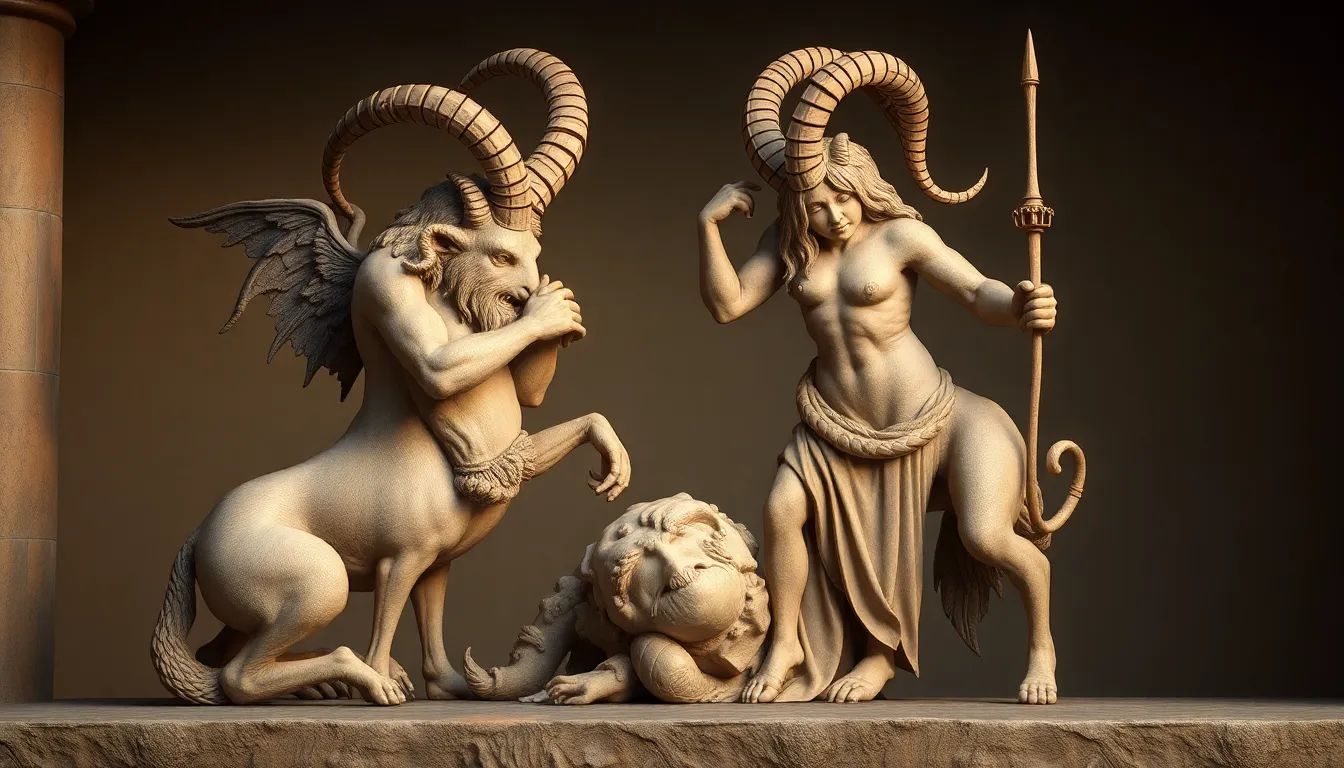The Relationship Between Satyrs and Other Mythical Creatures
I. Introduction
Satyrs are fascinating figures in Greek mythology, often depicted as half-man, half-goat beings embodying the spirit of revelry and nature. They are known for their playful and mischievous behavior, often associated with the god Dionysus, the deity of wine and festivity. This article aims to explore the relationships between Satyrs and other mythical beings, shedding light on their origins, connections, and the symbolic meanings they carry across various cultures.
II. Origins of Satyrs in Ancient Mythology
Satyrs have their roots deeply embedded in ancient Greek mythology, where they were often seen as companions of Dionysus. They embody the untamed aspects of nature and are closely linked to the themes of fertility, music, and dance.
The historical context of Satyrs reveals that they were initially portrayed as rustic gods, guardians of the woods and fields. Over time, they evolved into more complex characters, often depicted with exaggerated features such as pointed ears, horns, and tails, which emphasized their connection to the primal forces of nature.
Satyrs’ relationship with Dionysus highlights their role in celebrating the pleasures of life. They are often shown indulging in wine, dance, and music, representing the chaos and joy that comes with Dionysian festivals.
III. Satyrs and Nature Spirits
In Greek mythology, Satyrs share similarities with various nature spirits, such as Dryads and Naiads. While each of these beings has distinct characteristics, they all embody aspects of nature and its vitality.
- Dryads: Tree nymphs associated with oak trees, Dryads are gentle spirits that protect their natural surroundings.
- Naiads: Water nymphs found in rivers, springs, and lakes, Naiads are often depicted as more ethereal and delicate compared to the robust Satyrs.
The role of Satyrs in the natural world is one of guardianship and celebration. They interact with Dryads and Naiads, often participating in festivities that honor the bounties of nature. Their playful behavior contrasts with the more serene and nurturing nature of Dryads and Naiads, creating a dynamic interplay between chaos and harmony in the natural realm.
IV. Satyrs and Faunus: The Roman Connection
As Greek mythology transitioned into Roman culture, Satyrs were adapted and reimagined as Faunus, the Roman god of the forest, fields, and fertility. This transformation highlights both the continuity and divergence in the portrayal of these beings.
Similarities between Satyrs and Faunus include:
- Both are associated with nature, music, and revelry.
- Both have connections to fertility and agricultural abundance.
- Both are depicted as playful and mischievous, embodying the spirit of festivity.
However, differences exist as well. Faunus, while maintaining the satyr-like appearance, is often seen as a more benevolent figure, embodying the protective aspects of nature, whereas Satyrs can embody a more chaotic and hedonistic spirit.
V. Satyrs and Centaurs: Companions or Rivals?
Another intriguing aspect of Satyrs is their relationship with Centaurs, who are often depicted as half-human, half-horse beings. Centaurs are characterized by their dual nature, embodying both civilized and wild aspects, which creates an interesting comparison with Satyrs.
While both Satyrs and Centaurs inhabit the wild and are connected to nature, their interactions in mythology often showcase different dynamics:
- While Satyrs are primarily associated with revelry and play, Centaurs can embody both chaos and civilization, often depicted in conflicts between their wild instincts and societal norms.
- Satyrs are more closely linked to music and dance, while Centaurs are often portrayed as warriors and hunters.
In various myths, Satyrs and Centaurs are depicted as both companions and rivals, reflecting the complexities of their relationships. They often cohabit the same mythological spaces, leading to interactions that highlight their distinct characteristics and roles in the natural world.
VI. Satyrs in Folklore and Modern Adaptations
The influence of Satyrs extends beyond ancient mythology into contemporary folklore and modern adaptations. In fantasy literature and media, Satyrs have inspired a wealth of characters and narratives, often portrayed in various ways:
- In many stories, Satyrs are depicted as playful tricksters, embodying the spirit of freedom and revelry.
- They have appeared in popular fantasy series, such as C.S. Lewis’s “The Chronicles of Narnia,” where characters like Mr. Tumnus represent the Satyr archetype.
- Modern adaptations often explore themes of nature and chaos, placing Satyrs in contexts that examine the balance between civilization and the wild.
These representations highlight the enduring appeal of Satyrs as symbols of nature’s untamed spirit and the joys of life.
VII. Symbolism of Satyrs in Relation to Other Mythical Beings
Satyrs carry rich symbolism that resonates with themes of nature, chaos, and hedonism. Their relationships with other mythical beings often serve to convey deeper moral lessons and cultural values:
- Nature: Satyrs symbolize the wild, untamed aspects of nature, reminding humanity of its connection to the earth.
- Chaos: Their playful and chaotic nature serves as a contrast to order, reflecting the duality of existence.
- Hedonism: The indulgent lifestyle of Satyrs encourages a celebration of life’s pleasures, often serving as a critique of excessive restraint.
Through their interactions with other mythical beings, Satyrs convey important moral lessons, emphasizing the balance between chaos and order, nature and civilization.
VIII. Conclusion
The intricate relationships between Satyrs and other mythical creatures reveal a complex tapestry of symbolism, roles, and cultural significance. From their origins in ancient Greek mythology to their adaptations in modern storytelling, Satyrs continue to capture the imagination of people across generations.
As representations of nature’s wild spirit and the joys of life, Satyrs hold a unique place in the pantheon of mythical beings, reminding us of the importance of embracing both the chaos and beauty of the natural world.




